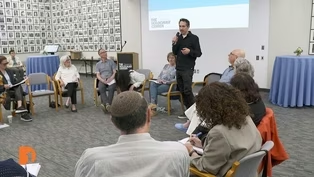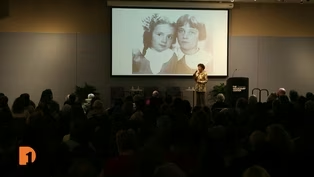
Commemorating the 100th anniversary of the civil rights case involving Dr. Ossian Sweet in Detroit
Clip: Season 10 Episode 21 | 4m 6sVideo has Closed Captions
The legacy of Dr. Ossian Sweet, 100 years after he defied segregation and defended his property.
We're discussing the 100th anniversary of the Detroit incident that involved Dr. Ossian H. Sweet and resulted in one of America's most famous civil rights trials. Contributor Stephen Henderson of American Black Journal sits down with Daniel Baxter, founder & CEO of the Dr. Ossian H. Sweet Foundation, to talk about Dr. Sweet's legacy.
Problems playing video? | Closed Captioning Feedback
Problems playing video? | Closed Captioning Feedback
One Detroit is a local public television program presented by Detroit PBS

Commemorating the 100th anniversary of the civil rights case involving Dr. Ossian Sweet in Detroit
Clip: Season 10 Episode 21 | 4m 6sVideo has Closed Captions
We're discussing the 100th anniversary of the Detroit incident that involved Dr. Ossian H. Sweet and resulted in one of America's most famous civil rights trials. Contributor Stephen Henderson of American Black Journal sits down with Daniel Baxter, founder & CEO of the Dr. Ossian H. Sweet Foundation, to talk about Dr. Sweet's legacy.
Problems playing video? | Closed Captioning Feedback
How to Watch One Detroit
One Detroit is available to stream on pbs.org and the free PBS App, available on iPhone, Apple TV, Android TV, Android smartphones, Amazon Fire TV, Amazon Fire Tablet, Roku, Samsung Smart TV, and Vizio.
Providing Support for PBS.org
Learn Moreabout PBS online sponsorship(inspiring music) - Let's just go through for people who don't know what happened, and I guess what lessons we can draw from it.
- Yeah, so Dr.
Sweet, he graduates from Wilberforce University, then Howard University.
While he's at Wilberforce, he hangs out in Detroit and he recognizes the growing African American community, and the fact that they don't have access to quality healthcare.
So he figures that he should start his practice in Detroit to provide that, and at the same time, make a nice sum of money.
So he moves to Detroit, he falls in love with a young lady by the name of Gladys Sweet.
They get married, he goes over to Europe to study the impact of radiation on the human anatomy under Nobel Peace Prize winning Madam Curie.
He comes back to Detroit and he's living with his in-laws.
The house is crowded because it's not just Dr.
Sweet, it's his two brothers, Henry and Otis that are living there.
He's a physician, a man of prominence.
So he comes across this home that's on sale on the corner of Garland and Charlevoix.
The people who own the house are an interracial couple, the Smiths, the wife is white, the husband is Black, but he's passing.
Nobody ever questions it.
They sell him the house for $18,500, three times the amount of the value because of the color of their skin.
Dr.
Sweet has no problem with that.
He makes a $3,500 deposit on the house, and they decide to move in.
So they move in on September 8th.
Crowds would gather, but not much happens that day.
On September 9th at eight o'clock, all hell breaks out.
The mobs surround their home, they rush the house, shots ring out, and a man is killed.
The Detroit Police Department comes in, they arrest everybody, charged them with first degree murder.
It's not just Dr.
Sweet and his wife.
But there are 11 people in this group.
So the NAACP hires Clarence Darrell.
Darrell comes to Detroit stands before Frank Murphy and affirms a man's home is his castle is his castle whether he's white or Black.
The turning point of the case is when they asked Dr.
Sweet to testify, and the co-council Arthur Garfield Hayes, asked him the poignant question, what did you think when you saw the crowd?
And Dr.
Sweet says, when I opened the door and I saw the mob, I realized that I was facing the same mob that had hounded my people throughout this entire history.
In my mind, I was pretty confident of what I was up against.
I had my back against the wall field with a peculiar fear, the fear of one who knows the history of my race.
I know what mobs had done to my people before.
And with that testimony, he would tell the story of how African Americans have had to struggle with mob violence ever since we've been in this country forever, right?
And that was the first time that all white male jury had an opportunity to take off their rose color glasses and see the world in black and white the same way Black people saw it, and understand the psychology of the defendants when that mob came.
And that was a turning point.
After that case, after that trial, Murphy would turn the case over to the jury, they would come back with no decision.
Murphy would declare it a mistrial, throw the case out.
And then in April, Dr.
Sweet's younger brother Henry would be retried because he's the one who actually testifies that he shot into the mob.
But after two hours, the jury will come back with a not guilty verdict.
Descendants of Holocaust survivors preserve their families’ stories
Video has Closed Captions
Clip: S10 Ep21 | 11m 29s | One Detroit looks at how the children of Holocaust survivors are carrying on their parents’ legacies (11m 29s)
Irene Miller, a Holocaust survivor’s story
Video has Closed Captions
Clip: S10 Ep21 | 7m 5s | Irene Miller speaks to One Detroit contributor Sarah Zientarski about survival, loss and strength. (7m 5s)
Providing Support for PBS.org
Learn Moreabout PBS online sponsorship
- News and Public Affairs

Top journalists deliver compelling original analysis of the hour's headlines.

- News and Public Affairs

FRONTLINE is investigative journalism that questions, explains and changes our world.












Support for PBS provided by:
One Detroit is a local public television program presented by Detroit PBS

